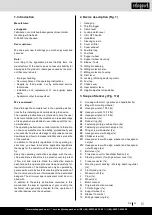
www.scheppach.com /
+(49)-08223-4002-99 /
+(49)-08223-4002-58
31
GB
m
ATTENTION! Never use a “pressure washer” to
clean your tiller. Water can penetrate tight areas of
the tiller and its transmission case and cause dam-
age to spindles, gears, bearings, or the engine. The
use of pressure washers will result in shortened life
and reduce serviceability.
m
CAUTION!
The muffler and other parts of the engine
(e.g. fins of the cylinder, spark plug) become hot during
operation and remain hot for a while after stopping the
engine. To reduce risk of burns do not touch the muffler
and other parts while they are hot.
Adjusting the clutch
m
ATTENTION!
The machine must not start to rotate un
-
til the clutch has been fully actuated.
This is achieved by adjusting the adjusting screws of the
clutch. In addition, the clutch lever must start the machine
first after max. 8 mm. If the settings are not sufficient
to meet these conditions (for example, if the adjusting
screw has been screwed up to the end of the thread),
please contact an authorized service center.
Blades / Tools
m
CAUTION!
Never repair damaged tilling attachments
by welding, straightening or modifying the blades. This
may cause parts of the cutting tool to come off and result
in serious or fatal injuries.
Lubrication (Fig. 9)
Remove the blades / tools (14) to lubricate the shafts at
least once a season.
Oil change
NOTE:
Please dispose of used motor oil in a manner that
is compatible with the environment. We suggest you take
it in a sealed container to your local service station for
reclamation. Do not throw it in the trash, pour it on the
ground, or down a drain.
Engine oil
CAUTION:
Operating the engine with a low oil level will result in
serious engine damage.
(See engine manual)
Transmission oil
The gearbox is filled with transmission oil by factory and
sealed. At the beginning of each season, make sure that
the interior of the gearbox is adequately lubricated.
•
Check gearbox oil level every 50 hours of operation.
•
Allow the transmission to cool down before refilling
with transmission oil.
•
After every 100 hours of operation it is necessary to
change the transmission oil:
1.
Check that the machine is in the horizontal position
2.
Open the closure (1g) by turning it and after the closure
(1f) (Fig.1).
3. Let the oil drain out of the gearbox until it is completely
emptied.
4.
Close the closure (1f).
5. Fill gearbox with SAE 15W-40 oil up to level (Fig.1)
6. Close the closure (1g).
Do not add too much transmission oil. Too much
transmission oil can create an overpressure that can
damage the seals.
Engine Maintenance
Follow the instructions in the engine manual!
Extra maintenance advisable
It is advisable to inspect the machine by a specialized techni-
cian at an authorized service network at the end of season,
if used intensively, and every two years if with normal use.
Any unauthorized changes and/or use of non-original re-
placement parts may result in serious injury or death to
the operator or third parties.
12. Storage
If the cultivator will not be used for a period longer than
30 days, follow the steps below to prepare your tiller for
storage.
1.
Drain the fuel tank completely. Stored fuel containing
ethanol or MTBE can start to go stale in 30 days. Stale
fuel has a high plastic content and can clog the carbu-
retor and restrict fuel flow.
2.
Start the engine and allow it to run until it stops. This en-
sures no fuel is left in the carburetor. Run the engine until
it stops. This helps prevent plastic deposits from forming
inside the carburetor and possible engine damage.
3. While the engine is still warm, drain the oil from the
engine. Refill with fresh oil of the grade recommended
in the Engine Manual.
4.
Allow the engine to cool. Remove the spark plug (18c)
and put 30 ml of high quality motor oil into the cylinder.
Pull the start lever (18) slowly to distribute the oil. Re-
place the spark plug (18c).
m
ATTENTION!
Remove the spark plug (18c) and drain
all of the oil from the cylinder before attempting to start
the unit after storage.
5.
Use clean cloths to clean off the outside of the tiller and
to keep the air vents free of obstructions.
m
ATTENTION!
Do not use strong detergents or petro-
leum based cleaners when cleaning plastic parts. Chem-
icals can damage plastics.
6. Inspect for any loose or damaged parts. Repair or
replace damaged parts and tighten loose screws,
nuts or bolts.
















































